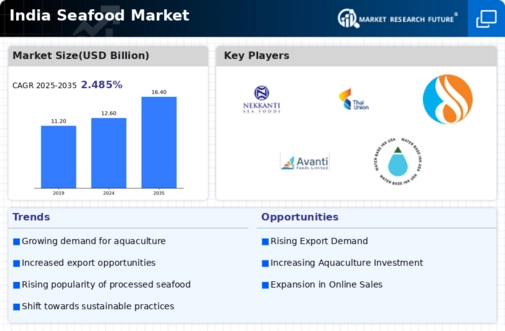Increasing Demand for Seafood Products
The seafood market in India is experiencing a notable surge in demand, driven by changing consumer preferences towards healthier protein sources. With a growing awareness of the nutritional benefits of seafood, including high omega-3 fatty acids, the market is projected to expand significantly. According to recent estimates, the seafood consumption in India is expected to grow at a CAGR of approximately 7% over the next five years. This increasing demand is not only limited to traditional seafood products but also includes value-added items such as ready-to-cook and processed seafood. The seafood market is thus adapting to these trends by diversifying product offerings to cater to health-conscious consumers.
Export Opportunities for Indian Seafood
The seafood market in India is poised to benefit from increasing export opportunities, particularly in regions with high demand for seafood products. Countries in the Middle East and Southeast Asia are emerging as key markets for Indian seafood exports. The Indian government has been actively promoting seafood exports through various initiatives, including subsidies and support for quality certification. In 2025, the seafood export value is projected to reach approximately $7 billion, reflecting a robust growth trajectory. This expansion in the export market is likely to bolster the seafood market, encouraging local producers to enhance their production capabilities and meet international standards.
Rising Urbanization and Changing Lifestyles
Urbanization in India is significantly influencing consumption patterns, particularly in the seafood market. As more people migrate to urban areas, there is a shift towards convenience and ready-to-eat food options. This trend is leading to an increased demand for processed and packaged seafood products. The urban population, which is expected to reach 600 million by 2031, is likely to drive the growth of the seafood market. Retailers are responding by expanding their seafood offerings in supermarkets and online platforms, making it easier for consumers to access a variety of seafood products.
Government Initiatives Supporting Aquaculture
The Indian government is implementing various initiatives to support the growth of aquaculture, which is a critical component of the seafood market. Programs aimed at enhancing fish farming practices, providing financial assistance, and promoting sustainable fishing methods are being introduced. The Pradhan Mantri Matsya Sampada Yojana, for instance, aims to increase fish production to 22 million tonnes by 2025. Such initiatives are expected to boost the seafood market by ensuring a steady supply of fish and seafood products, thereby meeting the rising domestic and export demand.
Technological Advancements in Seafood Processing
Technological innovations are playing a crucial role in enhancing the efficiency and quality of seafood processing in the seafood market. Advanced processing techniques, such as vacuum packaging and flash freezing, are being adopted to extend shelf life and maintain freshness. These technologies not only improve product quality but also reduce waste, which is a significant concern in the industry. Furthermore, the integration of automation and AI in processing plants is streamlining operations, leading to cost reductions. As a result, the seafood market is likely to see improved profitability and competitiveness, attracting more investments in the sector.
















Leave a Comment